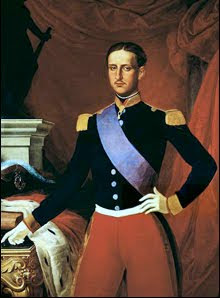 |
San Rocco, Paolo Gamba, chiesa di
S. Maria Assunta, Ripabottoni (CB).
Photo from I Principi Francone nel
Contado di Molise by Gabriella Paduano
and Fr. Gabriele Tamilia |
The 2022 calendar of the town of Ripabottoni, as conceived by Parish priest Don Gabriele Tamilia, contains rather beautiful pictures which distinguish each month of the year, unique iconic images which recount the history and architecture of the small Molise town. The purpose of the Calendar, is to raise funds for the restoration of the extremely valuable canvas painting of “Saint Rocco," patron saint of the town, which was created by local artist Paolo Gamba.
The Eighteenth century canvas is very deteriorated, has never been restored over time, and risks becoming irremediably lost.
The town Parish priest Don Gabriele Tamilia seeks through this Calendar to make the faithful aware of this problem and to save the altarpiece both from the artistic and religious point of view, as it represents the religious identity of all the Ripese.
Tax deductible charitable donations of 10 Euros per calendar may be made to the Parish. All those interested in art history and devotees of Saint Rocco are kindly asked to support this initiative. For further information in the Americas please contact Il Regno or Cav. Charles Sant’Elia.
• January – The Parish Church of Santa Maria Assunta, a national monument, and eighteenth century building designed by the Neapolitan architect Ferdinando Sanfelice with the stone coat of arms of the Francone family, the feudatories of the town from the 17th to 19th centuries.
• February - A partial view of the town immersed in nature.
• March - Particulars of stonework in the town.
• April - The fountain and an elderly woman bearing an antique copper basin on her head.
• May - The Palace of Prince Francone and an eighteenth century fountain.
• June - The main Square or Piazza of the town.
• July - A vintage photo of women at the fountain.
• August - The canvas depicting Saint Rocco, Patron of Ripabottoni, an Eighteenth century work by the Ripese painter Paolo Gamba, a disciple of the noted Neapolitan artist Solimena.
• September - “The fall of the rebellious Angels," a work by Solimena and a “Saint Matthew” by Paolo Gamba.
• October – A vintage picture of the town and its inhabitants.
• November - Monument to the Emigrants.
• December - “The Nativity” by Ripese painter Giambattista Gamba.
Santa Maria Assunta - Diocesi di (diocesitermolilarino.it)
Santa Maria dell'Assunta | Parrocchia Informa Morrone del Sannio e Ripabottoni
La Mission del Calendario Il calendario 2022 del borgo di Ripabottoni, ideato dal parroco Don Gabriele Tamilia, è caratterizzato da bellissime immagini che distinguono ogni mese dell’anno, iconografie uniche che raccontano la storia e l’architettura del piccolo paese molisano.
Il Calendario, ha la finalità di raccogliere offerte per il restauro della pregiatissima tela “di San Rocco”, patrono del paese, opera del pittore locale Paolo Gamba.
La Settecentesca tela è molto deteriorata, non è stata mai restaurata nel corso del tempo, rischia di andare irrimediabilmente perduta.
Il parroco del paese Don Gabriele Tamilia cerca attraverso tale calendario di sensibilizzare i fedeli a questo problema e salvare la pala d’altare sia dal punto di vista artistico che religioso, poiché rappresenta l’identità religiosa di tutti i ripesi.
Donazioni fiscalmente deducibili di 10 Euro per calendario potranno essere inviate alla Parrocchia. Tutti gli interessati della storia dell’arte ed i devoti di San Rocco sono gentilmente pregati di appoggiare questa iniziativa. Per ulteriori informazioni nelle Americhe si prega contattare Il Regno o Cav. Charles Sant’Elia.
• Gennaio - La chiesa parrocchiale di Santa Maria Assunta, monumento nazionale, edificio del Settecento dell’architetto napoletano Ferdinando Sanfelice e dal blasone in pietra della famiglia Francone, feudataria dal Seicento all’Ottocento del paese.
• Febbraio - Uno scorcio del paese immerso nella natura.
• Marzo - Particolari in pietra del borgo.
• Aprile - La fontana e una anziana signora che reca in testa un’antica conca di rame.
• Maggio - Palazzo del principe Francone e una settecentesca fontana.
• Giugno - La Piazza principale del paese.
• Luglio - Una foto d’epoca con le donne alla fonte.
• Agosto - La tela raffigurante San Rocco, Patrono di Ripabottoni, opera del Settecento del pittore ripese Paolo Gamba, allievo del noto pittore napoletano Solimena.
• Settembre - “La caduta degli Angeli ribelli” opera del Solimena e un “San Matteo di Paolo Gamba”.
• Ottobre - Una foto d’epoca del paese e dei suoi abitanti.
• Novembre - Monumento agli Emigrati.
• Dicembre - “La Natività” del pittore ripese Giambattista Gamba.
Santa Maria Assunta - Diocesi di (diocesitermolilarino.it)
Santa Maria dell'Assunta | Parrocchia Informa Morrone del Sannio e Ripabottoni



























































